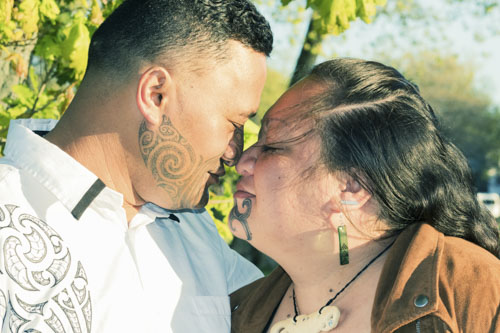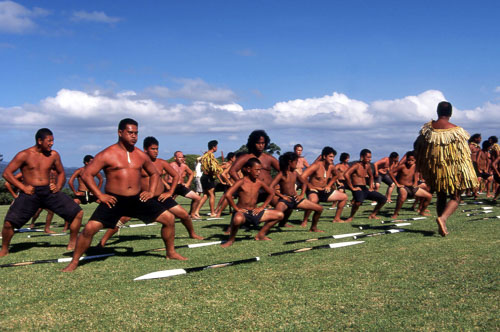Written by Lauren-Rose Stunell
In the above photo: A Māori statue in front of Volcano Taranaki, New Zealand
CASLT’s Discovering Languages series aims to spark interest in plurilingualism and pluriculturalism among language learners, school communities, and the public. Each featured language is explored in a blog article and accompanied by a classroom-ready activity for language teachers. Use these activities to promote and popularize language learning among your students and help them develop intercultural competencies.
New Zealand has three national languages: English, Māori, and New Zealand Sign Language. Today, 95% of New Zealanders speak English and around 4% (or 186,000) speak Māori, making it the second most predominant language. About 23,000 people know New Zealand Sign Language — about 0.5% of the population.
The Māori language is an integral part of New Zealand culture, with an annual celebration called “Te Wiki o te Reo Māori” (Māori Language Week), which encourages New Zealanders to speak Māori with pride and to protect the language.
Tangata Whenua: People of the Land
Māori, also known as te reo Māori (“the Māori language”), is the traditional language of the Māori people, a resilient Indigenous group whose traditional lands comprise mainland New Zealand. The Māori people are the tangata whenua, or people of the land. They have close ties to the land and celebrate the changes Mother Nature brings. Many similarities with North American Indigenous Peoples, the original inhabitants and land keepers of Turtle Island, can be found. Canada and New Zealand also share a similar history of British colonization.
The Māori Language in New Zealand and Beyond
Māori originally had no written language. The language was communicated using carvings and symbols to tell stories. With European contact, the English language began to adopt some Māori words that we still use today. Taboo is taken from the Māori word tapu, kit is kete, and we refer to New Zealanders as Kiwis — also a Māori word! Disney fans will also know a word in Māori — Moana, the name of the popular Polynesian heroine, which means “sea.”
Māori Greetings
Saying “Kia Ora” is the most common Māori greeting. In many cultures and countries, people accompany verbal greetings with a hug, a kiss on the cheek, a handshake, or a bow. The traditional Māori greeting is called the hongi. The hongi is performed when two people greet each other by pressing their noses or foreheads together. This greeting is a “sharing of breath,” which signifies a sacred welcome to a new friend. The Māori greeting is also used at “Pōwhiri,” a sacred welcoming ceremony for those honoured by an invitation to join in learning about Māori culture.

The Power of Language and Dance
You may already know the Māori for their impressive “haka” performances all over the world. These were popularized by the famous rugby team the All Blacks performing before their games. The haka is used to spark passion and bravery in the warriors performing it, and to intimidate opponents into backing down and avoiding battle. Haka performances feature aggressive facial expressions used to engender fear in those watching. The Māori language is also an important part of haka, with chants in Māori accompanying the movements.

In modern day, we see the haka’s powerful combination of movement and language used to celebrate special events such as birthdays, weddings, and funerals. This NPR video offers insight into the beauty and history of haka.
Although the Word is Small, the Meaning is Great . . . Kia Ora!
Learning Objectives
At the end of this lesson, students and teachers will be able to greet each other in the Māori language. They will understand the importance of words in Māori and how they have a deep meaning of history, tradition, and story. They will begin to understand the values of the Māori and the importance of the land to them. They will also be able to connect those values to the land in which they live by learning from the Indigenous peoples of Canada.
Introduction to the Lesson
To begin, ask students how they greet each other in their own language and culture. Allow them time to explain how they say hello and the customary ways to greet others, such as through handshakes or hugs. You may ask questions such as these:
- In your culture, is it customary to greet each other with a hug?
- How would you greet your grandparents?
- Do you think other countries find it strange to greet strangers with a handshake?
Teachers and educators can also use the article “Beyond the Handshake: How People Greet Each Other Around the World” to discuss other customary greetings.
Activity Sequence
Understanding “Kia Ora”
Ask students to watch this short video on the meaning of “Kia Ora.” You may choose to use the following questions for a class discussion or worksheet:
- What are some of the many meanings behind the term “Kia Ora”?
- What does saying “Kia Ora” acknowledge?
- Why do the Māori people have so much respect for the land?
- Where do Māori designs for tattoos and artwork come from?
- Why do the Māori say that “Kia Ora” means more than “hello”; it comes from the heart?
Māori Pronunciation
Work as a class to understand how to pronounce Māori words. This video, “Māori (The REAL Language of New Zealand),” offers insight on the letter sounds and how to correctly pronounce Māori words.
The Māori language consists of the following five vowel sounds:
- a (‘a’ as in ‘car’)
- e (‘e’ as in ‘egg’)
- i (‘i’ like the ‘ee’ in ‘tee’)
- o (‘o’ as in ‘four’)
- u (‘u’ like an ‘o’ in ‘to’)
Vowels can be long or short. A long vowel is signified with a macron above it. For example:
- a — (short vowel); papa (earth)
- ā — (long vowel); pāpā (father)
There are eight consonants in Māori, similar to h, k, m, n, p, r, t, and w in English. There are also two different consonants — ‘wh’ and ‘ng’. The ‘wh’ sounds like the English ‘f’. The ‘ng’ sounds like the ‘ng’ in English words like ‘sing’, except that in Māori, words can start with ‘ng’.
Greetings in Māori
Explain to students that there are different ways you can greet someone in Māori. This means that when you say hello, it is special and unique to every person you welcome, which helps build connections. As a class, you can practice the different ways to say hello and good morning in Māori:
- Mōrena — Good morning
- Ata Mārie — Good morning
- Tēnā Koe — Hello/greetings to one person
- Tēnā Kōrua — Hello/greetings to two people
- Tēnā Koutou — Hello/greetings to three or more people
- Kia ora tātou/kia ora koutou — Hello/greetings everyone
- Nau mai, haere mai — Welcome
- Kei te pēhea koe? — How are you?
- Kei te pai — Good
- Tino pai — Really good
Concluding the Activity
To conclude, have students write a reflection on why it is important to greet others. What traditions lie behind how they greet their friends? What is the importance and meaning of greeting others? How does saying hello make an important first impression? How does saying hello mean different things to different people from around the world?
Extending the Activity for Older Audiences
Mature students may further their thinking by creating a mind map or Venn diagram using their knowledge of Indigenous Peoples of Canada.
- What similarities can you see between the Māori people and the Indigenous Peoples of Canada? How does each Indigenous group honour and respect the land?
- What challenges have the Indigenous people of New Zealand and Canada both faced due to colonization?
- What lessons could Canada learn from New Zealand about saving Indigenous languages?




